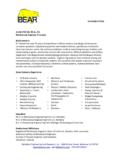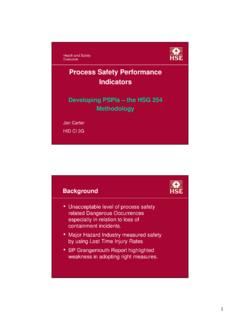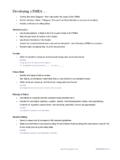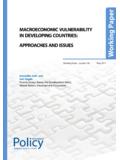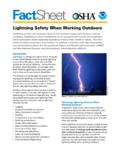Transcription of Overhead Powerline Early Warning Devices for …
1 Overhead Powerline Early Warning Devices for Cranes, Lifts and other Aerial Mobile Equipment David Andres, EIT Glen Stevick, , Berkeley Engineering And Research, Inc. May 15, 2014 Backround Today's heavy industry (construction, agriculture and manufacturing) is characterized more and more by the use of mobile powered equipment. From 1993 to 1996 alone, the sales of boom based machines increased by nearly 200 The result is that more workers are using hydraulically driven boom machines and scissor lifts for a wide range of activities that used to be accomplished by other means. Figure 1. Fire at a construction site caused (left) and electrocution at a mine, both caused by crane contact with an Overhead Powerline .
2 While this is a boon for the industry, fewer workers are required to accomplish more in less time, the use of these machines pose new dangers that need to be addressed. In particular, these types of machines, with their extended reach and increasing height, can and have contacted Overhead powerlines during operation with devastating results. Powerlines provide power to also relieve man of the burden of heavy labor. They are a pervasive presence traversing nearly all of our roadways and need to operate at high voltages (many thousands of volts). This paper describes the testing of Powerline detection systems, provides the testing data and describes the development of a new multi-antenna electric-field detector.
3 1 Aerial Work Platforms, Find Boom Lifts, Scissor Lifts and Fork Lifts. High voltage power lines range from over 700Kv (for long distance transmission) down to 120v (delivered to residential customers) , but are more commonly encountered in the 10Kv range: Figure 2. Graphic illustrating the voltage values for different parts of the electrical distribution According to a NIOSH report (National institute for occupational safety and health) 5,348 workers died from contact with high voltage lines between 1980 and 1992 and this is before the huge boom in heavy lifting equipment This makes electrocution the fifth leading cause of death in the work place or roughly 7% of all work related deaths.
4 A great deal of research and attention has been given to assessing methods for determining the proximity to power lines at construction and work sites where the presence of the power lines are This article is focused on the case of mobile truck cranes for delivering or picking up material or products , manlifts, portable television antennae booms and other Devices , where there is usually no need to operate close to a power line. The operator is primarily concerned about the presence or absence of a power line. If a power line is present, they can simply move a significant distance away. The pickup and delivery of agricultural produce bins is an example. 2 Page 13 Title:"Final Report on the August 14, 2003 Blackout in the United States and Canada" Dated April 2004, By US Department of Energy 3 Worker Deaths by Electrocution, By Department of Health and Human Services, May 1998, DHHS (NIOSH) Publication No.
5 98-131 4 A Performance Evaluation of Two Overhead Power Line Proximity Warning Devices , By Gerald T. Homce, , James C. Cawley, , and Michael R. Yenchek, , Information Circular 9510 Department of Health and Human Services DHHS (NIOSH) Publication No. 2009 110, November 2008. Agricultural Produce Delivery Berkeley Engineering And Research (BEAR) has recently investigated two cases where an agricultural worker died when the boom on his truck made contact with a rural power transmission lines while he was picking up bins (for avocados), to put them on the flatbed portion of the truck, see Figures 3 below: Figure 3. Photographs of agricultural flat bed truck with crane (left) and just after a nighttime power line contact incident (right).
6 It is common practice for field workers, when harvesting during the day, to leave the harvested goods in large plastic or wooden bins which are then gathered by drivers during night hours. The accident corresponding to the truck/crane photographs shown in Figure 3 occurred in May 2006 in San Diego, California. A worker on a routine pickup assignment, was fatally burned and electrocuted when his boom touched a power line. The vehicle in question was a common flatbed truck with a hydraulically powered boom lift mounted to it's bed. A similar Powerline contact fatality incident involving the same type of truck and crane occurred a year earlier in the same general area.
7 If these truck/cranes were equipped with a readily available proximity Warning device (PWD), the operator may have been warned of the power lines presence and these deaths may have been avoided. In an effort to scientifically determine if a PWD would have helped, BEAR purchased one of the commercially available Warning Devices and conducted testing to evaluate it's efficacy. Warning Devices There are numerous Devices currently available that will detect the presence of high voltage lines. All of these Devices work by detecting electric fields. While a magnetic field (both electric and magnetic fields are generated by electric currents) is easier to sense, their magnitude depends upon the magnitude of the current flowing through the line.
8 The strength of an electric field is a function of voltage alone and remains constant irrespective of current flow. Thus sensing the electric field, while somewhat more difficult, should be more reliable and produce more consistent results. These types of Devices are manufactured by numerous companies and readily available. Three examples are Modell 2200L by Allied Safety Devices , Model PV5007 by ProxyVolt, and Sigalarm by Sigalarm. Testing BEAR purchased a device manufactured by Sigalarm for testing. The device comes with all the necessary hardware to needed to install it on to any common boomed machine. This includes the solid state controller box (see Figure 4), high amplitude alarm horn, antenna sensor, mounting brackets, and interconnection wiring harness.
9 The Sigalarm device was assembled in such a way that it is easily handled by a single individual approaching or retreating from a high voltage source. This consisted of a cart housing the controller, a power source and affixing the antenna to a 6 foot wand that could be manipulated by hand. Figure 4. Sigalarm controller and alarm horn. A small high voltage line system was constructed (see Figure 5) using two different neon power supplies (8 Kv and 20 Kv) to test the Sigalarm's efficacy in detecting high voltage. The Sigalarm controller includes seven different sensitivity settings which can be set to trigger the alarm at different distances from the high voltage source.
10 This is an important feature for close-in calibration of a known Powerline as different voltages will produce different electric fields and the proximity alarm will sound at different distances for the same setting. This adjustability allows for operating near known high voltage lines and picking a specific repeatable distance at which the device will sound an alarm. Figure 5. Test high voltage line. The wires were set at a 10 foot height. BEAR was most interested in validating the device when set to it's maximum sensitivity, used as a Powerline presence detector. Our data is as follows: 8 Kv source. (n/a indicates the alarm was not triggered) Sensitivity Setting Alarm Trigger Distance (feet) 10 n/a 20 n/a 30 0 40 8 50 20 60 30 70 50 20 Kv source Sensitivity Setting Alarm Trigger Distance (feet) 10 n/a 20 1 30 4 40 11 50 25 60 40 70 50 The distance at which the device triggered an alarm was not affected by the orientation of the sensing antennas.
